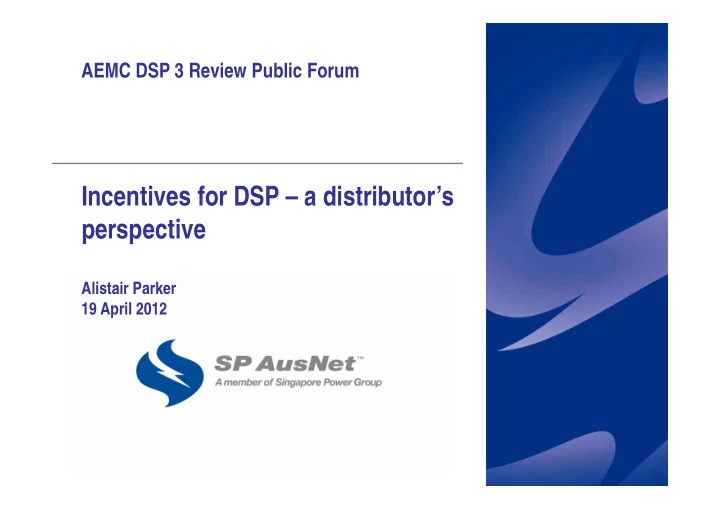

AEMC DSP 3 Review Public Forum Incentives for DSP – a distributor’s perspective Alistair Parker 19 April 2012
Overview • AEMC Directions Paper • DSP’s importance • Preference for incentives • Cost reflective pricing • Critical Peak Pricing Case Study
AEMC Directions Paper • SP AusNet supports the findings of the Directions Paper • Encouraged by further consideration of: • options for appropriate commercial incentives for distribution businesses (DBs) towards DSP options • possible temporary arrangements which help DBs manage any additional risks • the potential for DBs to provide DSP products to consumers 3
DSP is increasingly important SP AusNet Peak Demand Vs Annual Load 20,000.00 2000 18,000.00 1800 16,000.00 1600 14,000.00 1400 12,000.00 1200 GWh MW 10,000.00 1000 8,000.00 800 6,000.00 600 4,000.00 400 2,000.00 200 - 0 2002 2003 2004 2005 2006 2007 2008 2009 2010 Month/Year GWh MW We need alternatives to continued capital investment
Incentives work • SP AusNet supports financial incentives over regulatory obligations and cost recovery • Range of potential incentives: • higher-powered incentive scheme similar to the S-factor to reward efficient demand side response (demand reduction) • innovation and R&D rewards 5
A high power DSP incentive • A high powered incentive scheme like S-factor: • based upon a value of reduced energy consumption • target based on net benefits achieved, energy or capacity saved • Well-designed scheme would involve: • an appropriate measurable target • an adequate quantum of reward • the marginal incentive rate • caps or floors to mitigate the risks of the incentive 6
Incentive options • Rewarding Innovation and R&D is key to driving DSP: • An “obligations-led” approach to regulation will hinder innovation and R&D • Rewards of innovation and R&D are generally long term in nature: • Under building block regulation, rewards are truncated • Ofgem has implemented Innovation Funding Incentive (IFI) to address this issue: • IFI has yielded some positive results 7
Cost-reflective pricing • Strongest driver of DSP will be a cost reflective price signal: • Gives consumers and potential investors the future cost of consumption • Provides a financial incentive for them to change their consumption and /or investment behaviour, if beneficial • This allows the community to optimise its use of its current resources, therefore, maximising community welfare • SP AusNet’s critical peak pricing tariff as a case study 8
Case study : Critical Peak Tariff <160MWh (large LV, HV and Sub-transmission customers) Tariff Approved Tariff Component The demand charge based on the average of customer ’ s maximum kVA recorded on the 5 nominated peak demand weekdays during the Defined Two Part Critical Peak Demand Period. Demand Charge Capacity Charge based on the Capacity of the connection assets Days must be in summer (+ March), and the days will be nominated and Defined Critical communicated to customers at least one day in advance. Peak Demand The period only includes between 2pm-6pm on that nominated day. Period The 5 maximum ’ s are averaged and used as the basis for the demand charge for the next 12 months. Energy Charge Similar to existing charges Standing Charge Similar to existing charges 9
Case study : Critical Peak Tariff • 2011 summer period* saw a marked response to the critical peak tariff. Of 1,800 industrial customers: • 66% reduced their demand from the nominated value • Over 300 reduced their demand by more than 50% • Over 75 customers achieved reductions above 90%. • This represented a net 88MW reduction in peak demand * The 2011 Victorian summer was mild so caution must be taken before intimating all the observed demand reduction was due just to the new tariff. 10
Case study : Critical Peak Tariff Customer without generation 600 500 400 7-Mar-11 11-Mar-11 18-Mar-11 kVA 300 24-Mar-11 29-Mar-11 Weekday 200 100 0 0:30 1:30 2:30 3:30 4:30 5:30 6:30 7:30 8:30 9:30 10:30 11:30 12:30 13:30 14:30 15:30 16:30 17:30 18:30 19:30 20:30 21:30 22:30 23:30 Time Note Times are
Case study : Critical Peak Tariff Customer with generation kVA 100 150 200 250 300 350 400 50 0 0:30 1:30 2:30 3:30 4:30 5:30 6:30 7:30 8:30 9:30 10:30 11:30 Time 12:30 13:30 14:30 15:30 16:30 17:30 18:30 19:30 20:30 21:30 22:30 Note Times are 23:30 29-Mar-11 24-Mar-11 18-Mar-11 11-Mar-11 7-Mar-11
Concluding remarks • Price signals work • Retailers pass on the network price signals • Creating the right price signal creates a market product • If ‘Time of Use’ tariffs are rolled out for domestic and commercial customers, will this ignite the DSP market? • Incentives work • Further work to develop scheme with suitable parameters 13
Recommend
More recommend